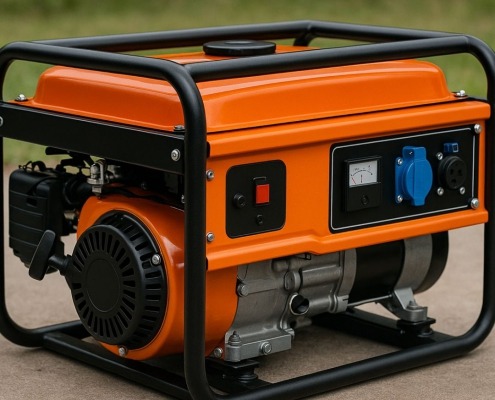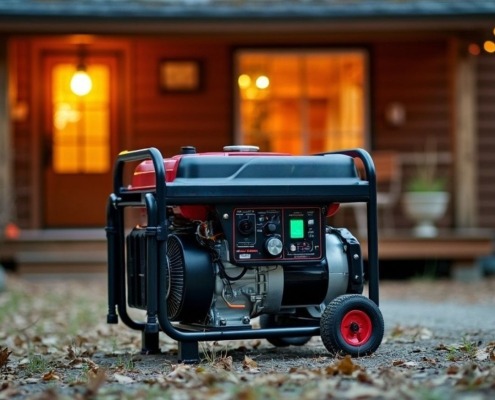Troubleshooting a Generator That Runs But Produces No Power
Steven E / Monday May 5, 2025
Generators are lifesavers when the power goes out. Whether you’re powering your home during a storm, running tools at a job site, or keeping your RV running off-grid, a good generator can keep life moving. So it’s incredibly frustrating when your generator starts up just fine, but then, nothing. No lights. No power. No juice.
Don’t worry. If your generator runs but isn’t producing power, it doesn’t necessarily mean the whole thing is toast. In fact, a lot of common causes can be fixed with basic tools and a little patience.
We’ll walk you through the step-by-step troubleshooting process, help you identify what’s wrong, and even show you a few simple ways to fix it yourself, no expensive repair shop required.
The information in this article may not apply to your specific appliance model. We recommend consulting your manufacturer’s documentation or contact us with any questions.
Step 1: Safety First – Before You Start Troubleshooting
Working with generators means working with electricity and fuel, so safety is your top priority.
Here’s what to do before poking around:
- Turn off the generator.
- Unplug all devices and loads from the generator outlets.
- Allow the engine to cool down if it’s hot.
- Keep the area well-ventilated if you’re working indoors or in a garage.
- Wear gloves and eye protection if you’ll be handling electrical parts.
Once it’s safe, you’re ready to dig into what’s really going on.
Step 2: Eliminate the Obvious – Are You Getting Power at All?
Let’s start with the basics. Sometimes, the problem is simpler than it seems.
Check the outlets:
- Plug a known-working appliance or tool directly into the generator outlet.
- Try multiple outlets on the generator.
- Flip the circuit breakers or reset buttons on the generator panel.
Generators often come with built-in breaker switches or reset buttons that protect against overloads. If they’re tripped, your generator will appear dead even though the engine is running fine.
Give them a press, then try plugging in your device again.
Step 3: Check for Residual Magnetism Loss
Believe it or not, generators can lose their ability to generate electricity if they sit too long unused. This is often due to something called loss of residual magnetism, the small amount of magnetic field stored in the rotor that helps kickstart power production.
If the generator hasn’t been used in a while (or was running without a load), the magnetic field may fade, and the unit won’t produce voltage even though the engine runs normally.
Signs of this issue:
- Generator runs fine, but zero output
- No humming or slight “buzz” at the outlets
- Happens after long storage or first-time use
Here’s a classic workaround:
- Plug a corded electric drill into the generator outlet (make sure it’s off).
- Start the generator.
- Hold down the drill’s trigger and manually spin the drill chuck (in the correct direction).
- The quick jolt of reverse-generated current can “excite” the alternator and restore magnetism.
If this works, you’ll hear the drill come to life and your outlets should be live again.
Step 4: Inspect the AVR (Automatic Voltage Regulator)
The AVR is a small but mighty part of your generator that regulates the output voltage. If it fails, your generator might run but deliver no power, or fluctuating voltage that can’t support devices.
Where to find it:
- Usually located under a side cover or behind the control panel.
- It’s a small electronic board with wires connected to the stator.
Symptoms of a bad AVR:
- No voltage at outlets
- Dim or flickering lights (if you have a voltmeter or load light)
- Burned or discolored components on the AVR board
What to do:
- Disconnect the AVR (label the wires first).
- Inspect for visible damage.
- Use a multimeter to check voltage coming out of the AVR.
- If it’s not functioning, replacements are usually available online by model number.
AVRs are often easy to replace and cost anywhere from $15 to $50, depending on your generator.
Step 5: Test the Brushes and Slip Rings
Generators use carbon brushes and slip rings to transfer power from the rotating rotor to the electrical system. If the brushes are worn out or the slip rings are dirty, you could lose output.
How to check:
- Unplug the generator and remove the rear housing.
- Locate the brush holder, usually two spring-loaded carbon blocks pressing against circular slip rings.
- Inspect for: excessive wear, broken springs and carbon buildup or oil on slip rings.
DIY fix:
- Clean the slip rings gently with fine sandpaper or contact cleaner.
- Replace brushes if they’re less than 1/4 inch long or visibly worn.
Brushes are inexpensive and widely available. Replacing them can bring a “dead” generator back to life instantly.
Step 6: Inspect the Capacitor (For Capacitor-Style Generators)
Some generators don’t use an AVR, they use a capacitor to help regulate voltage. If the capacitor fails, your generator can’t build or maintain an electric charge.
Symptoms of a bad capacitor:
- Generator starts but no power at outlets
- Capacitor looks swollen, cracked, or leaking
- Voltage spikes or no output
How to test:
- Remove the capacitor (note the wiring first).
- Use a multimeter with capacitance mode to check its rating.
- If it’s out of spec or visibly damaged, replace it.
Capacitors are cheap, and replacing one is often a 10-minute job.
Step 7: Check the Rotor and Stator
These are the big internal components responsible for producing AC power. While they rarely fail completely, it can happen, especially if your generator has seen heavy use or was overloaded frequently.
Testing requires:
- A multimeter to check for continuity across stator windings.
- Checking for shorts to ground.
- Inspecting rotor windings for continuity and resistance.
If either component is damaged, you may need to replace the stator or rotor. This is a more involved repair but can be done at home with the right part and a bit of patience.
Step 8: Look at the Control Board
If your generator is modern or inverter-style, it may use a digital control board to manage power output and protect against overloads.
A failed board can stop the generator from sending power to the outlets.
Unfortunately, testing a control board is harder without diagnostic tools. But signs include:
- Display won’t turn on or flickers
- No output even with good AVR and brushes
- Burned or scorched spots on the circuit board
If you suspect the board is bad, replacements are often available online. Just be sure to search by exact model number.
Step 9: Try a Load Test
Once you’ve made a repair or replaced a part, test your generator under a small load before plugging in anything sensitive like electronics or appliances.
How to do it:
- Plug in a 60–100 watt incandescent bulb or basic tool.
- Start the generator and let it warm up.
- Gradually increase the load with another device.
- Use a voltmeter to confirm stable output (usually around 120V for household models).
If everything looks good, your generator is officially back in business.
Additional information
Thank you for reading! We hope this guide helped you get your generator working again.
If you have any other appliance repair needs or projects, don’t hesitate to explore our other troubleshooting guides and videos.
If you need replacement parts or some extra help with ordering them, grab your model number and head over to AppliancePartsPros.com, where you can chat with a pro, read our DIY blog and more.
Be sure to subscribe to us on YouTube and follow us on Facebook, Twitter and Instagram!
With nearly a decade of experience in providing top-notch customer service regarding appliance parts and repair, Steven enjoys sharing practical advice, troubleshooting tips, and interesting information to help readers stay informed.





